Page 286 of 361
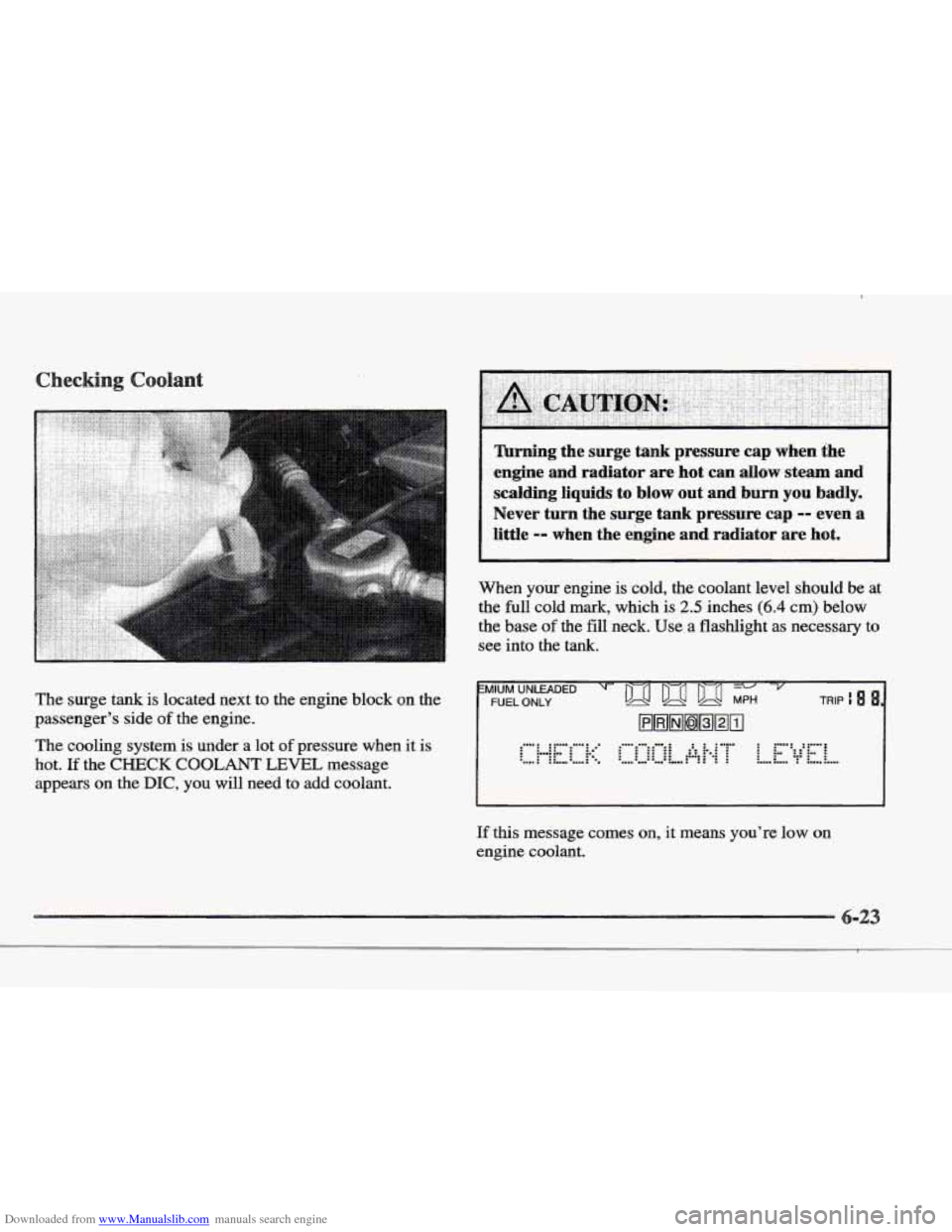
Downloaded from www.Manualslib.com manuals search engine The surge tank is located next to the engine block on the
passenger's side
of the engine.
The cooling system is under a lot
of pressure when it is
hot. If the CHECK COOLANT LEVEL message
appears on the
DIC, you will need to add coolant.
Turning the surge tank pressure cap when the
engine and radiator are hot can allow steam and
scalding liquids to blow out and burn you badly.
Never
turn the surge tank pressure cap =- even a
little -- when the engine and radiator are hot.
When your engine is cold, the coolant level should be at
the full cold mark,
which is 2.5 inches (6.4 cm) below
the base
of the fill neck. Use a flashlight as necessary to
see into the
tank.
MlUM UNLEADED - -
FUEL ONLY
DS Dg a ML
HHBHBBrn
........... ....... ." .......................... ...... ....... , : :: :: .-. :. : : ............. :.no. ... ..... : :L...-"..: ".L... ..... .............. .....
.... ...... ............ . .. . .I ......... .... . . -. . . .".. .".. .I.. ..". ." ...
If this message comes on, it means you're low on
engine
coolant.
Page 288 of 361
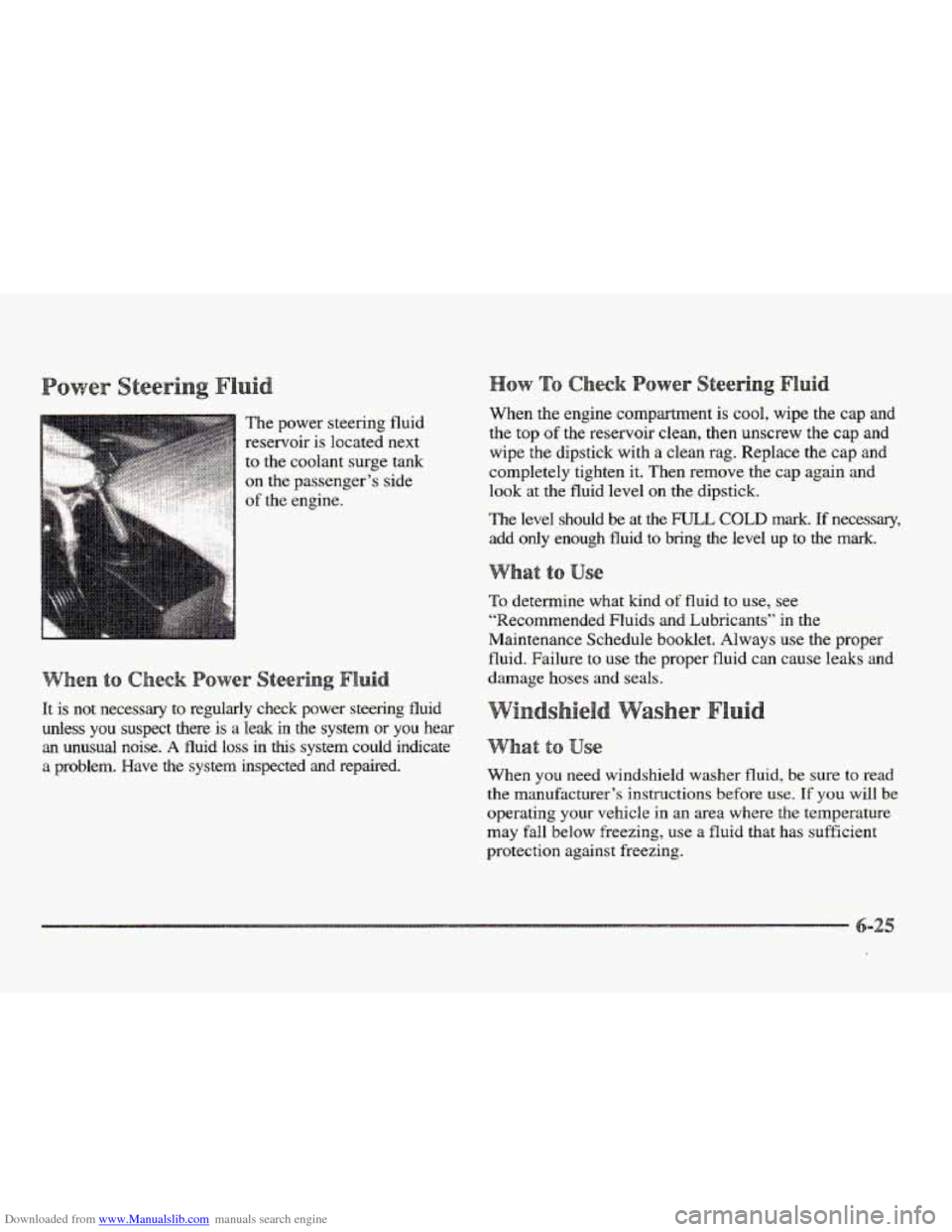
Downloaded from www.Manualslib.com manuals search engine The power steering fluid When the engine compartment is cool,
wipe the cap and
the top
of the reservoir clean, then unscrew the cap and
wipe
the dipstick with a clean rag. Replace the cap and
completely tighten
it. Then remove the cap again and
look
at the fluid level on the dipstick.
The level should be at
the FULL COLD mark. If necessary,
add only enough fluid to bring the level up to the mark.
ec
It is not necessary to regularly check power steering fluid
unless you suspect there is a leak
in the system or you hear
an unusual noise. A fluid loss in thls system could indicate
a problem. Have the system inspected and repaired.
To determine what lund of fluid to use, see
“Recommended Fluids
and Lubricants” in the
Maintenance Schedule booklet. Always use
the proper
fluid. Failure to use
the proper fluid can cause leaks and
damage hoses and seals.
When
YOU need windshield washer fluid, be sure to read
the manufacturer’s instructions before use. If you will be
operating your vehicle
in an area where the temperature
may fall
below freezing, use a fluid that has sufficient
protection against freezing.
Page 301 of 361
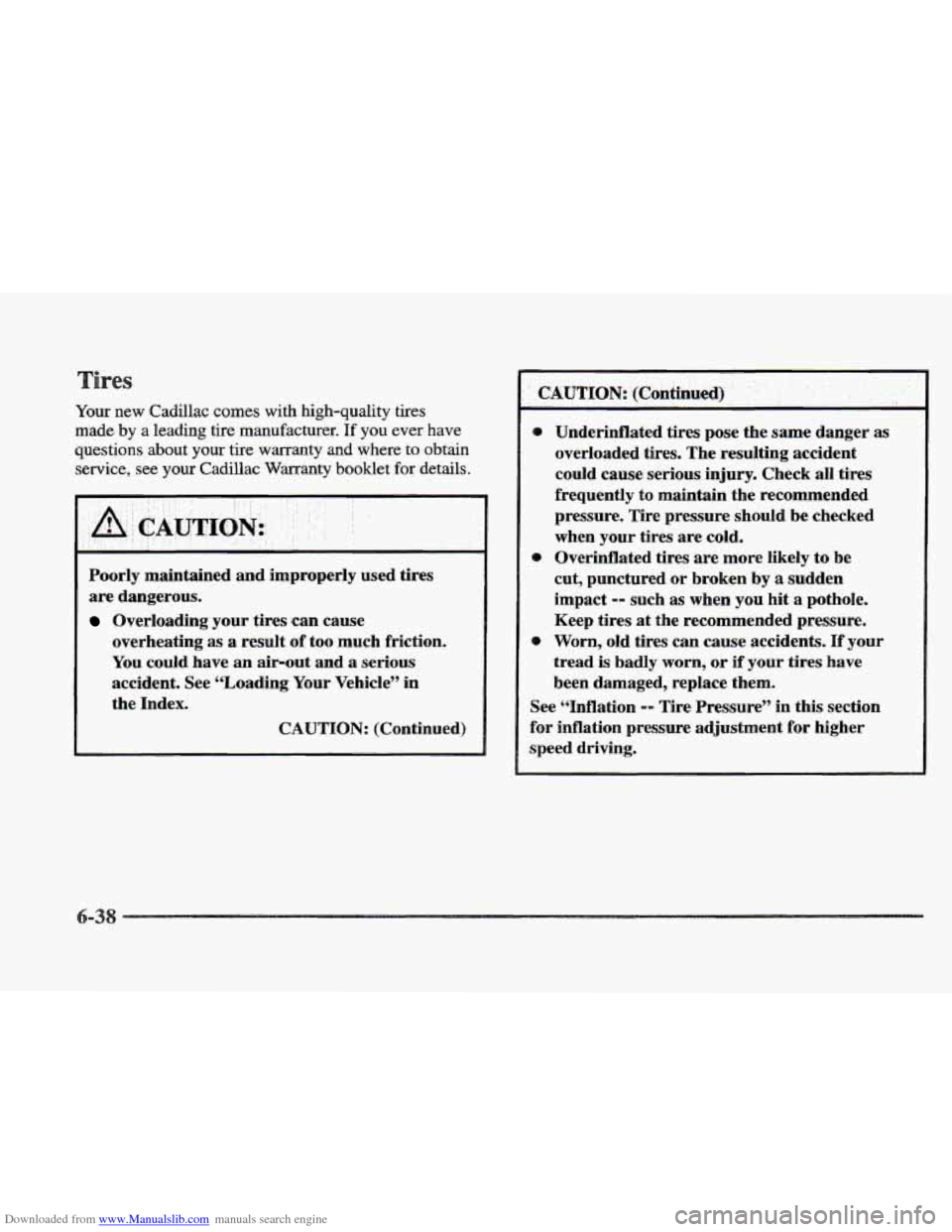
Downloaded from www.Manualslib.com manuals search engine Your new Cadillac comes with high-quality tires
made
by a leading tire manufacturer. If you ever have
questions about your tire warranty and where to obtain
service,
see your Cadillac Warranty booklet for details.
..
,A CAUTION:: ..
Poorly maintained and improperly used tires
are dangerous.
Overloading your tires can cause
overheating as
a result of too much friction.
You could have an air-out and
a serious
accident. See “Loading Your Vehicle” in
the Index.
CAUTION: (Continued)
I .CAUTION: (Continued) ’ .. ’ . ..
@ Underinflated tires pose the same danger as
overloaded tires. The resulting accident
could cause serious injury. Check
all tires
frequently to maintain the recommended
pressure. Tire pressure should
be checked
when your tires are cold.
cut, punctured or broken
by a sudden
impact
-- such as when you hit a pothole.
Keep tires at the recommended pressure.
@ Worn, old tires can cause accidents. If your
tread is
badly worn, or if your tires have
been damaged, replace them.
See “Inflation
-- Tire Pressure” in this section
for inflation pressure adjustment for higher
speed driving.
e Overinflated tires are more likely to be
Page 302 of 361
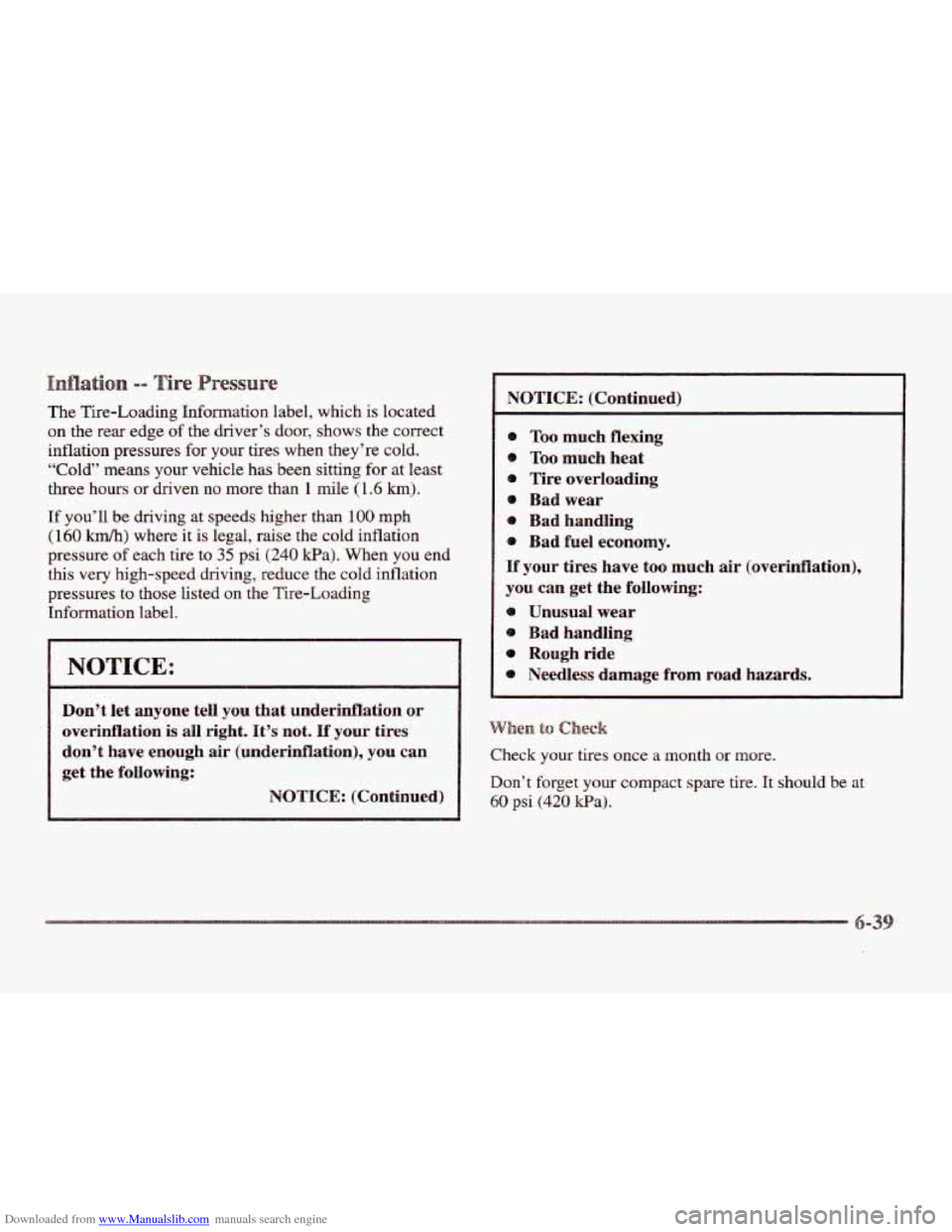
Downloaded from www.Manualslib.com manuals search engine The Tire-Loading Information label, which is located
on the rear edge
of the driver’s door, shows the correct
inflation pressures
for your tires when they’re cold.
“Cold” means
your vehicle has been sitting for at least
three hours or driven
no more than 1 mile (1.6 km).
If you’ll be driving at speeds higher than 100 mph
( 160 kmk) where it is legal, raise the cold inflation
pressure
of each tire to 35 psi (240 Wa). When you end
this
very high-speed driving, reduce the cold inflation
pressures to those listed
on the Tire-Loading
Information label.
I NOTICE:
Don’t let anyone tell you that underinflation or I
overinflation is all right. It’s not. If your tires
don’t
have enough air (underinflation), you can
get the following:
.NOTICE: (Continued)
NOTICE: (Continued)
e Too much flexing
Too much heat
@ Tire overloading
Bad wear
@ Bad handling
e Bad fuel economy.
If your tires have too much air (overinflation),
YOU can get the following:
@ Unusual wear
~b Bad handling
0 Rough ride
@ Needless damage from road hazards.
Check your tires
once a month or more.
Don’t forget your compact spare tire. It should be
at
60 psi (420 Wa).
-3
Page 303 of 361
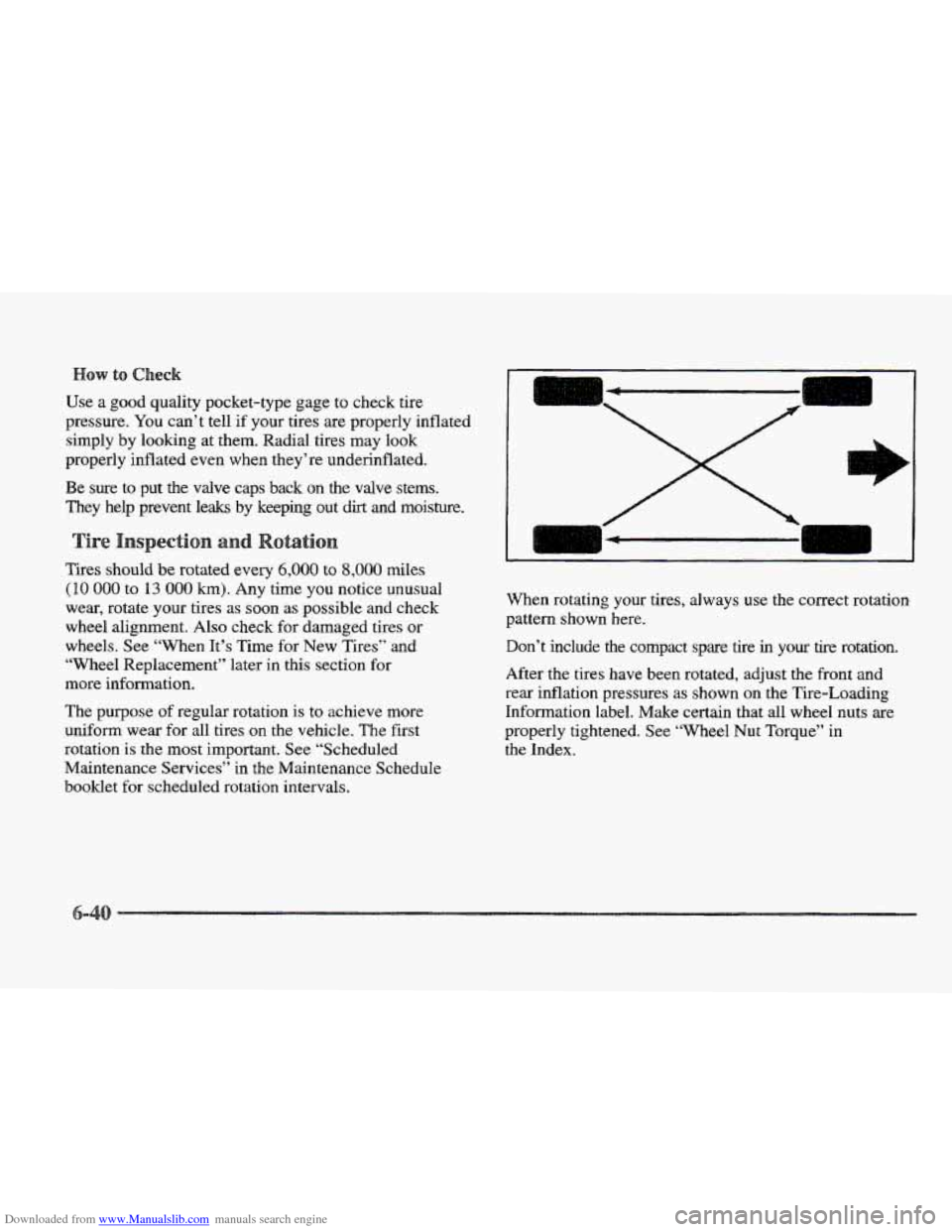
Downloaded from www.Manualslib.com manuals search engine Use a good quality pocket-type gage to check tire
pressure. You can’t tell if your tires
are properly inflated
simply by looking at them. Radial tires may look
properly inflated even when they’re underinflated.
Be
sure to put the valve caps back on the valve stems.
They help prevent leaks by keeping out dirt and moisture.
Tires should
be rotated every 6,000 to 8,000 miles
(10 000 to 13 000 km). Any time you notice unusual
wear, rotate your tires
as soon as possible and check
wheel alignment. Also check for damaged tires
or
wheels. See “When It’s Time for New Tires” and
“Wheel Replacement’’ later in this section for
more information.
The purpose of regular rotation is to achieve
more
uniform wear for all tires on the vehicle. The first
rotation is the most important. See “Scheduled
Maintenance Services” in the Maintenance Schedule
booklet for scheduled rotation intervals.
I
When rotating your tires, always use the correct rotation-
pattern shown here.
Don’t include the compact spare tire
in your tire rotation.
After the tires have been rotated, adjust the
front and
rear inflation pressures as shown on the Tire-Loading
Information label. Make certain that all wheel nuts are
properly tightened. See “Wheel
Nut Torque” in
the Index.
Page 304 of 361
Downloaded from www.Manualslib.com manuals search engine One way to tell when it’s
time for new tires is to
check the treadwear
indicators,
which will
appear when your tires have
only 1/16 inch (1.6 mm) or
less of tread remaining.
You need a new tire if any of the following statements
are true:
You can see the indicators at three or more places
around the
tire.
cb You can see cord or fabric showing through the
tire’s rubber.
8 The tread or sidewall is cracked, cut or snagged deep
enough to show cord or fabric.
e The tire has a bump, bulge or split.
@ The tire has a puncture, cut or other damage that
can’t be repaired well because of the
size or location
of the damage.
Page 313 of 361
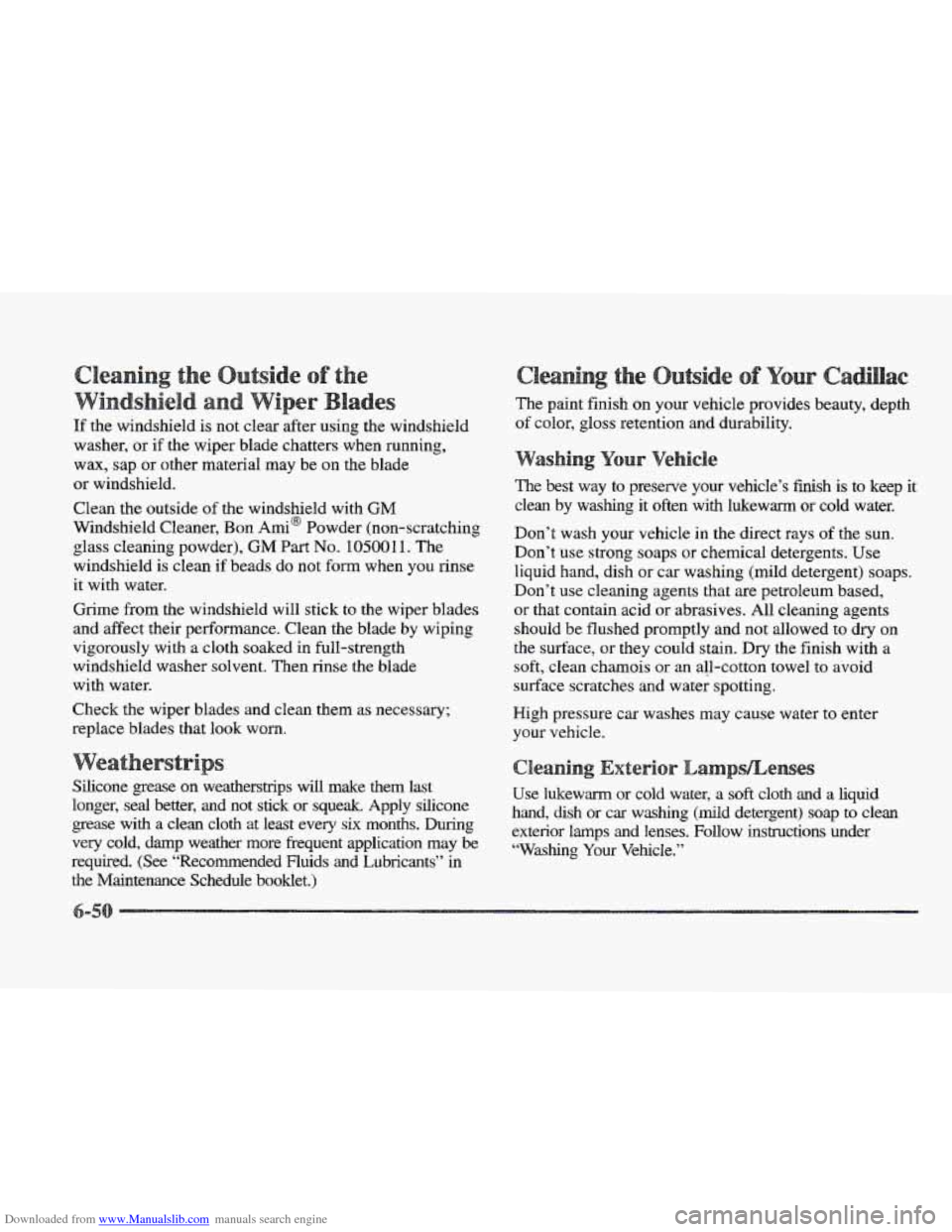
Downloaded from www.Manualslib.com manuals search engine es
If the windshield is not clear after using the windshield
washer, or
if the wiper blade chatters when running,
wax, sap or other material may be on the blade
or windshield.
Clean the outside of the windshield with
GM
Windshield Cleaner, Bon Ami@ Powder (non-scratching
glass cleaning powder),
CM Bart No. 105001 1. The
windshield is clean if beads do not form
when you rinse
it with water.
Grime from the windshield will stick to the wiper blades
and affect their performance. Clean the blade by wiping
vigorously with a cloth soaked in full-strength
windshield washer solvent. Then rinse the blade
with water.
Check the wiper blades and clean them as necessary;
replace blades that look worn.
s
Silicone grease on weatherstrips will make them last
longer, seal better, and not stick or squeak. Apply silicone
grease with a clean cloth at least every
six months. During
very cold, damp weather more frequent application may be
required. (See “Recommended Fluids and Lubricants” in
the Maintenance Schedule booklet.)
e e e
The paint finish on your vehicle provides beauty, depth
of color, gloss retention and durability.
The best way to preserve your vehicle’s finish
is to keep it
clean by washing it often with lukewarm or cold water.
Don’t wash your vehicle in the direct rays
of the sun.
Don’t use strong soaps
or chemical detergents. Use
liquid hand, dish or car washing (mild detergent) soaps.
Don’t use cleaning agents that are petroleum based,
or that contain acid
or abrasives. All cleaning agents
should be flushed promptly and not allowed to dry
on
the surface, or they could stain. Dry the finish with a
soft, clean chamois or an all-cotton towel to avoid
surface scratches and water spotting.
High pressure
car washes may cause water to enter
your vehicle.
ea enses
Use lukewarm or cold water, a soft cloth and a liquid
hand,
dish or car washing (mild detergent) soap to clean
exterior lamps
and lenses. Follow instructions under
“Washing Your Vehicle.”
Page 318 of 361
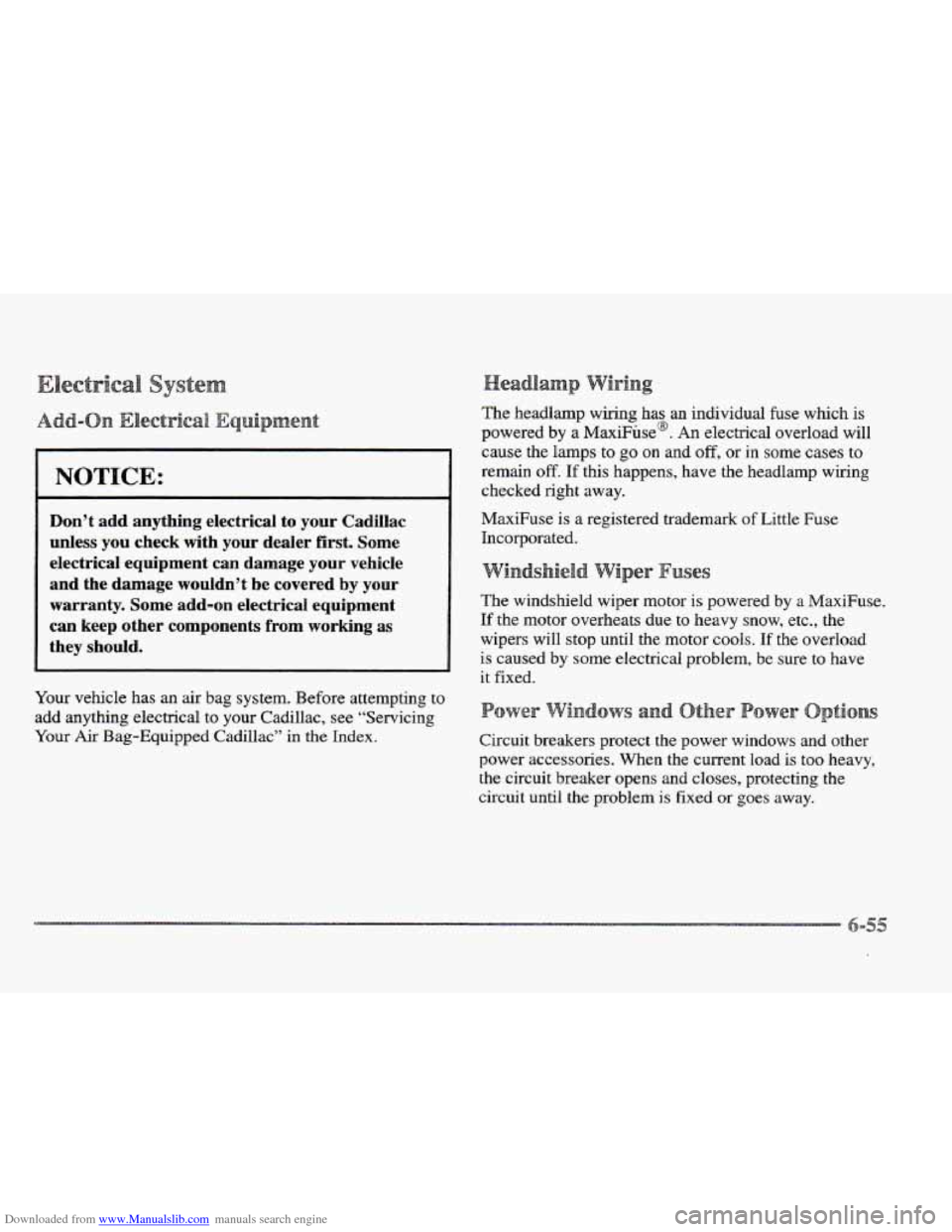
Downloaded from www.Manualslib.com manuals search engine NOTICE:
Don’t add anything electrical to your Cadillac
unless
YOU check with your dealer first. Some
electrical equipment can damage your vehicle
and the damage wouldn’t be covered by your
warranty. Some add-on electrical equipment
can keep other components from working as
they should.
Your vehcle has an air bag system. Before attempting ta
add anything electrical to your Cadillac, see “Servicing
Your Air Bag-Equipped Cadillac”
in the Index. The headlamp wiring
has an individual fuse which is
powered by a MaxiFuse? An electrical overload will
cause the
lamps to go on and off, or in some cases to
remain
off. If this happens, have the headlamp wiring
checked right away.
MaxiFuse is
a registered trademark of Little Fuse
Incorporated.
The windshield wiper motor is powered by a MaxiFuse.
If the motor overheats due to heavy snow, etc., the
wipers will stop until the motor cools.
If the overload
is caused
by some electrical problem, be sure to have
it fixed.
Circuit breakers protect
the power windows and other
power accessories.
When the current load is too heavy,
the circuit breaker opens and closes, protecting the
circuit
until the problem is fixed or goes away.